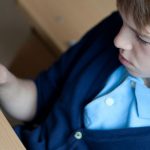The ability to go to the toilet independently is something that most of us take for granted.
Toilet training is also about teaching what is involved in the routine actions of using the bathroom.
For many of our students here at Giant Steps the process of learning to go to the toilet becomes complicated by their communication and sensory needs. Some children learn to go to the toilet quickly, however for others is can take several years of hard work.
It is important to understand that going to the toilet is not only about the successful urinating and passing bowel movements. In the early years a large amount of time is spent teaching children about what is involved in the routine of going to the toilet including:
- Transitioning to the bathroom space
- Managing clothing to take pants down
- Remaining seated on the toilet
- Using paper
- Managing clothing to pull pants up
- Flushing
- Washing hands
- Transitioning to the next activity
We have recently developed our own school toileting visuals with the assistance of one of our staff members Kate Curtain who has incredible drawing skills (Thank you Kate!) We have implemented these visuals across the school and made adjustments where necessary reflective of the students’ needs at particular stages of their life. Please see the attached visual templates and feel free to adjust and adapt to your own needs.
When teaching the steps of this routine we advocate for the bathroom space to be as “non-verbal” as possible. This means that when teaching the students the steps we refer to the visual supports or provide the least amount of prompting possible via modelling, gesture or physical prompts rather than spoken language. The reason for this is that students can become reliant on a staff member to “talk” them through the steps of the process. Instead, if we direct their attention to the visual support then support person can gradually withdraw whilst leaving visual supports in place and facilitating independence in this area. Remembering that independence in this area is the ultimate goal of the toilet training process.
How will they know when is it time to go to the toilet? We can communicate toilet times to students by scheduling it into their daily routine at consistent times using visual supports. Research shows us that the best time to use the toilet is 20 minutes after meal times. This provides us several opportunities a day to implement a consistent routine.
Bathrooms are full of intense sensory experiences including bright light, noisy tiles, cold surfaces and water. We then expect our children to sit for a sustained period on the toilet calmly in order to be successful using the toilet. On top of this at school they are complicated by many people accessing the bathroom space at the one time which can add noise and movement to the environment. Being aware of the child’s individual sensory needs and making adaptions for these in the bathroom space is crucial for them to remain regulated whilst completing their toileting routine. At times calming sensory input needs to be planned prior to going into the bathroom space. Individual sensory experiences should be consistently embedded into the toilet routine to ensure the child is in the best possible place for learning to become independent in the toilet.
There are many areas that need to be considered to progress toilet training on to the next step after the routine is consistently in place including:
- any additional medical complications
- fluid intake
- dietary intake
- readiness of the child
- readiness of the family
- major events occurring e.g. moving house, starting a new school, holidays
- anxiety
As there is no one approach that works for all children in terms of toilet training, considering these areas will assist in setting reasonable expectations for the child. It is important that all aspects of the child’s development and environment are considered and that communication to caregivers is clear to ensure that consistent implementation occurs when toilet training.








